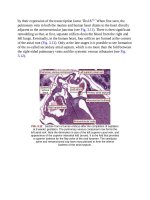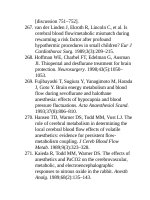Andersons pediatric cardiology 173
Bạn đang xem bản rút gọn của tài liệu. Xem và tải ngay bản đầy đủ của tài liệu tại đây (97.32 KB, 3 trang )
MeasurementofFetalVolumeBlood
Flow
Accuratemeasurementofvolumesofflowinperipheralvesselsisofclinical
interestbecauseitreflectsdifferentialperfusionoforgansinthefetus,both
duringnormalgrowthandinresponsetoadversecircumstances.Inanimal
models,flowofbloodcanbemeasuredwithahighdegreeofaccuracywith
electromagnetic167ortransit-timeflowmeters.168Becausethesemethodsrequire
aninvasiveapproach,theycannotcurrentlybeappliedinstudiesofhuman
fetuses.Noninvasivemethodstomeasurethevolumeofflowintheaortaare
confoundedbymethodologicdifficulties,mostlyinrelationtoaccurate
measurementsofaorticdiameter,anissuethathasstillnotbeenresolved,despite
improvementsintheresolutionofultrasound.124,169
Humanfetalbloodflowhasbeenmeasuredwithahighdegreeofaccuracy
usingcardiacmagneticresonance.Inthischapterwewillconcentrateonthe
muchmoreextensivelyreportedecho-Dopplertechniques.
Themethodtraditionallyusedtoestimatevolumeofflowinavesselisfrom
theproductofthevelocitytimeintegraloftheDopplersignalinthevessel,the
heartrate,andaseparateestimationoftheareaofthelumenfromstatic
measurementsofitsdiameter.Theinherenterrorinthismethodisestimatedto
beaslargeasone-fifthwhenmeasuringfetalarteries.124Thiserrormostly
resultsfromlimitsofresolutionofthediameter,butfailuretoaccountfor
changesinpulsatileflowmayaccountforalmostone-tenthofthedifferencein
volumeofflowcomparedwithstaticassessment.170Estimationsofvenousflow
havebeenreported,171butthepotentialerrorisfurthercompoundedbythe
assumptionthatthevesselunderexaminationiscircular.
Simultaneousmeasurementofthediameterofthepulsatilevesselandthe
meanvelocityofflowallowsanestimateofflowvolumeinthedescendingaorta
ofthehealthyfetus.169Thevolumeofaorticflow,measuredinthisway,has
shownalinearincreasewithincreasinggestation,beingestimatedat225
mL/minperkgbodyweightinfetusesof250days.
EstimationofPerfusionUsingPowerDoppler
MethodsusingnewerDopplermodalitieshavebeenevaluatedassurrogate
estimatesofperfusion.PowerDopplerwasinitiallyinvestigatedasamethodto
estimateperfusionintheadult,butanimportantmethodologicproblemwasthe
formationofrouleauxthatartificiallyelevatedthemaximalvalueforpower
Doppleramplitude.Fortunately,studiesinthefetusconfirmthatfetalblooddoes
notformrouleauxtoanysignificantdegree,permittingacomparisonof
perfusionofdifferentorgans.StudiesusingquantificationofpowerDoppler
havesuggestedanincreaseinpowerDopplersignalsfromtheplacenta,lungs,
spleen,liver,andkidneyupto34weeksofgestation,followedbyadecreasein
allbutthespleen,whichremainsconstant.Abnormalitiesintheratioofvolumes
inthebrainandlungswereseeninhigh-riskpregnancies,butmethodologic
problemsusingthistechniquemaylimittheconclusionsdrawnbysuchstudies.
Meanpixelintensitywastheoriginalmethoddevelopedtoassessperfusionover
aregionofinterestbutwasdependentnotonlyonthevolumeofflowofblood
butalsodepth,gain,andattenuationinoverlyinglayersoftissue.Thiswas
supersededbyanalternativemethod,thefractionalmovingvolume,that
attemptedtocompensatefortheseconfoundingvariablesbyassigningavalueof
100%amplitudetoalargevesselwithintheregionofinterestandcomparingthe
amplitudeinsmallervessels,suchasthosesupplyingthefetalkidney.172–174
Pitfallslimitingreliabilityofthismethodincludethedepthoftheimagedorgan
fromthetransducer.Phantomstudiesdescribethatthepowerislinearlyrelated
tovelocityoveralimitedrange,suggestingitmaybeusefultodiscriminate
betweennormalanddecreasedfetalperfusioninorganssuchasthelung.
ValidationofmeasurementswithpowerDopplerultrasoundhasbeenperformed
insheepusingradioactivemicrospheres,showinggoodcorrelationsinthe
adrenalgland.175ItwasproposedthatpowerDopplermethodsmaybeimproved
bycombiningthemwith3Dstandardizedtechniquestoidentifyareproducible
anatomicplaneformeasurement,176andthistechnologyisnowavailableusing
virtualorgancomputer-aidedanalysis(VOCAL).Itisnowpossibletoacquirea
3DpowerDopplerimageoftheorganofinterest,andVOCALsoftwareinthe
ultrasoundmachinecancalculateavascularizationindexrepresentingthe
percentageofcoloredovertotalvoxelsintheorgantoassessitsvascularity(Fig.
6.18).177
FIG.6.18 PowerDopplerandthree-dimensional(3D)standardized
techniqueshaveenabledamethodofvolumeflowassessmentusing
virtualorgancomputer-aidedanalysis(VOCAL).Thisfigureshowsa3D
powerDopplerimageofasacrococcygealteratomaandVOCALsoftware
intheultrasoundmachinecancalculateavascularizationindex(VI%)
representingthepercentageofcoloredovertotalvoxelsintheorganto
assessitsvascularity.
3Dand4DEchocardiographyandQuantification
ofVolumeandEjectionFraction
Allimagingtechniquesdependonexcellentqualityofimaging,so3Dvolume
estimationisonlyasgoodasthecross-sectionalimage,andqualitymaybe
compromisedbyfetalmovementsandmaternalrespiration.Newertechnology
withshorteracquisitiontimespermitlivereal-time3Dimagingandtherapid
acquisitionofa3Dvolumesetthatcanbemanipulatedlaterofflineforexpert
analysis.178
Morerecently,physiologicinformationonstrokevolume,cardiacoutput,and
ejectionfractionhasbeenreportedusing3Dinversionmodesonographyand4D
spatiotemporalimagecorrelationusingtheVOCALmodalities.179,180









